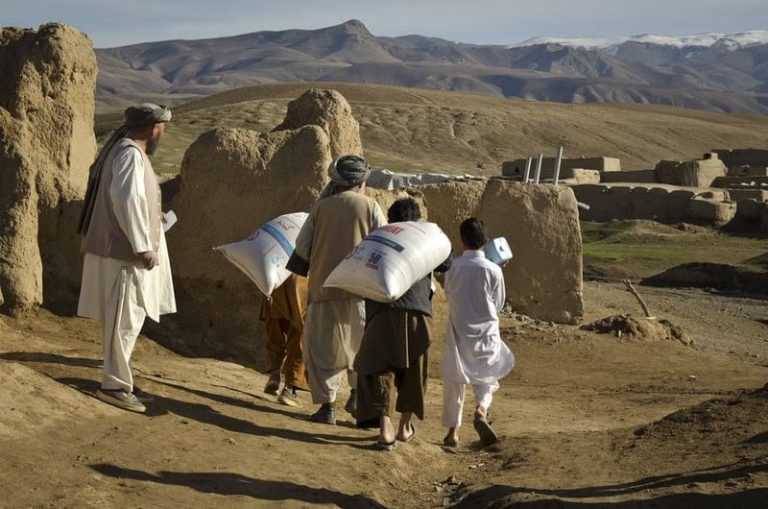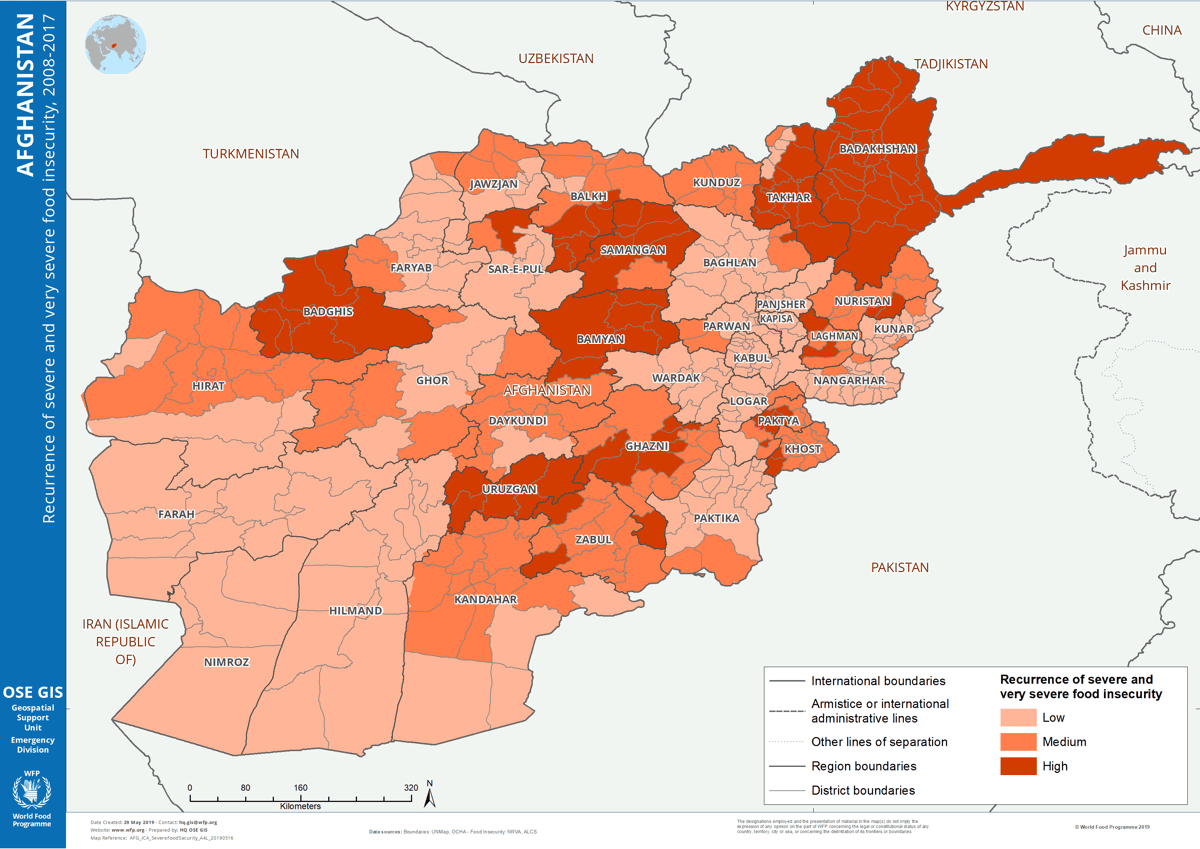Tech
Data-driven humanitarianism
Published
3 years agoon
By
Terry Power
It’s one of the most beautiful places on Earth, but its people are among the most vulnerable. Afghanistan’s snowy mountains and fertile foothills give way to arid plateaus, offering a contrast often described as stark and gorgeous. The nexus of ancient East-West trade routes, this landlocked country hosts many languages, artisan traditions, and centuries of influence from Islamic, Buddhist, and Hindu customs. It’s also a place where an estimated 12.4 million are living in hunger, and where droughts, floods, and conflict often make access routes impassable for humanitarian convoys.
Working to end hunger for the people of Afghanistan, despite climate change and conflict challenges, is the World Food Programme (WFP). In 2020, the Norwegian Nobel Committee awarded the Nobel Peace Prize to WFP for these efforts. As the world’s largest humanitarian organization addressing hunger and promoting food security for 100 million people in 88 countries, WFP set a goal for zero world hunger by 2030.
“Saving lives is not enough,” says Lara Prades, who leads WFP’s geospatial unit. “We also need to change lives.” Most people think WFP is “just dropping aid from planes in the event of a hurricane,” but there’s another side to its mission. “It actually is participatory, and we work with communities to improve nutrition and food security.”
Prades speaks of a “dual mandate”—respond to immediate food scarcity and pinpoint underlying problems to create long-term solutions. Prades and her team start with smart maps showing near real-time data about weather, supply routes, and road conditions. They perform advanced analytics to specify the exact challenges for each region. WFP outreach plans are reinforced by face-to-face conversations with local people, discussing real-world implications of what appears on the map.
In the central Afghanistan city of Bamiyan, celebrated for two monumental Buddha statues carved into the side of a cliff in the sixth century and destroyed by the Taliban in 2001, Prades spent time drinking tea with people who live there. “If the map is telling us this area is highly vulnerable, and on top of that, they have had these floods and droughts,” Prades says, “we go and meet the people and talk to them.”
These conversations validate what the maps and analyses say, and they help WFP planners understand the best intervention for each region, even accounting for seasonal or yearly variations. It’s a data and discovery process crucial in Afghanistan and around the world as WFP aims to end world hunger within this decade.

Mapping root causes
The advances in geospatial technology to map, manage, and automate the analysis of food insecurity data comes at a time when the frequency and intensity of hunger-related emergencies is escalating because of climate change.
In the days and hours leading up to a heavy storm or weather catastrophe, WFP teams use maps from a geographic information system (GIS) to quickly determine who will need support, where, and how to reach them. Outside of emergency response, they apply GIS analysis to detect underlying threats—such as floods and droughts that have degraded farmland or conflict that have closed transportation routes.
“We’re doing this in a quite sophisticated fashion—how we combine geospatial data to identify where to position long-term programs for tackling recurring food insecurity and also disaster reduction,” Prades says.
Even with advanced mapping capabilities, the outreach depends on local touchpoints. Prades and her team will ask people, “what worries you the most?” It may be firewood or goat vaccinations, a fear of camels getting sick, or preparations for the maize harvest. The concerns become data layers, added to smart maps to recognize trends or hotspots, and point to possible mitigation efforts.
“You need to see the linkages,” Prades says, “to see all the connections of how that is translating into actual benefits for the people who we are trying to help.”
WFP staff use this location intelligence to determine where to deliver food rations and position programs such as flood protection, irrigation systems, or plant nurseries. For the people of Afghanistan, smart maps also help WFP staff negotiate access routes with government officials or non-state armed groups to reach far-flung or isolated regions.
Democratizing insights
When Prades started with WFP in 2008, the organization was using GIS for basic data visualization to map the results of food security assessments. Now, geospatial technology supports advanced analytics generated by a modern GIS and web applications for complex logistics and near real-time data sharing.
“We call this a spatial data infrastructure,” Prades says. “It’s really allowing us to store, process, and share all the geospatial data and make it accessible to all levels of the organization. We are all working with the same data.”
On any given day, WFP coordinates an average of 5,600 trucks, 50 ocean shipments, 92 aircraft, and 650 warehouses across the globe. Operational staff tap the geospatial infrastructure to coordinate aid deliveries.
“We produce reference maps with the transportation network for logistics staff to plan their routes and see what roads they can access with what trucks,” says Thierry Crevoisier, GIS officer at WFP headquarters in Rome.
Teams on the ground constantly provide new information—what’s happening with the roads, where are the schools and markets, where are security challenges. The new data syncs across routing applications for safe aid delivery. Live maps and dashboards link to automatic early warning systems set to trigger intervention before a weather event. Most remarkable to Prades is how the technology “is not driven by the technical people, but instead by the users, by the operators.”
People in each country served by WFP accept accountability for updating information or bringing in open source data, such as conflict maps. The live updates to dashboards and apps allow WFP workers to plan against difficulties and lower risks when delivering aid or conducting field assessments.
Proactive and real-time logistics
When floods recently struck South Sudan, WFP was working to deliver food to people stranded by floods in Indonesia and the Philippines. With climate-related events on the rise, Prades highlighted increased calls for preliminary impact analysis to make resources ready when and where disasters strike. This measure would reduce scenarios where WFP teams are stretched thin or mobilizing in reactive ways.
Geospatial technology enables such analysis, overlaying an anticipated storm path or earthquake epicenter with the locations of vulnerable populations before an event. In the aftermath, WFP teams rely on those same smart maps—loaded with local data and satellite imagery—to route supplies.
“The humanitarian world is changing,” Prades says. “Once we know there is an event coming, we have a window of two weeks. What kind of interventions can we already implement in those two, three weeks to be able to mitigate the impact of the upcoming shock?”
In Mozambique, a country that experiences major flooding every few years, Prades and her team created flood-hazard models showing potential damage and people affected. The models can be run against security assessments and road conditions as well as WFP resources. Seeing this location-based insight ahead of actual flooding moved WFP planners from a mindset of response to one of preparedness.
“They start shifting the way they think,” Prades says. “Where can we pre-position certain stocks based on the flood-risk areas? Where are the routes that are most efficient to take when this happens? Normally people tend to be very reactive—we don’t tend to think before the event happens.”
The possibility of zero hunger
The covid-19 pandemic deepened food insecurity for the world’s most vulnerable people, those already racked by conflict and climate-related disasters. WFP estimates 96 million more people in 54 countries reached acute hunger levels in 2020, adding to the 137 million accounted for in 2019.
In its mission to end world hunger, WFP aligns with one of the Sustainable Development Goals developed by United Nations and adopted in 2015 by the global community.
Though the pandemic has made this goal more difficult, Prades sees the collaborative work of multiple agencies as a way to strengthen the fight. And the geospatial tools she builds can empower that collaboration while continuing to serve the dual mandate of meeting immediate needs and addressing underlying causes.
“It’s a different approach, and it’s quite promising,” Prades says. “My dream is there’s no more hunger.”
This content was produced by Insights, the custom content arm of MIT Technology Review. It was not written by MIT Technology Review’s editorial staff.
You may like
-


Making the world a data-driven place with the cloud
-


Sustainable IT: A data-driven decarbonization strategy
-


Cloud computing helps Finnish bank OP Financial become a data-driven organization
-


The future of manufacturing is iterative, collaborative and data-driven
-


Maximize business value with data-driven strategies
-


Getting the most from your data-driven transformation: 10 key principles

My senior spring in high school, I decided to defer my MIT enrollment by a year. I had always planned to take a gap year, but after receiving the silver tube in the mail and seeing all my college-bound friends plan out their classes and dorm decor, I got cold feet. Every time I mentioned my plans, I was met with questions like “But what about school?” and “MIT is cool with this?”
Yeah. MIT totally is. Postponing your MIT start date is as simple as clicking a checkbox.
COURTESY PHOTO
Now, having finished my first year of classes, I’m really grateful that I stuck with my decision to delay MIT, as I realized that having a full year of unstructured time is a gift. I could let my creative juices run. Pick up hobbies for fun. Do cool things like work at an AI startup and teach myself how to create latte art. My favorite part of the year, however, was backpacking across Europe. I traveled through Austria, Slovakia, Russia, Spain, France, the UK, Greece, Italy, Germany, Poland, Romania, and Hungary.
Moreover, despite my fear that I’d be losing a valuable year, traveling turned out to be the most productive thing I could have done with my time. I got to explore different cultures, meet new people from all over the world, and gain unique perspectives that I couldn’t have gotten otherwise. My travels throughout Europe allowed me to leave my comfort zone and expand my understanding of the greater human experience.
“In Iceland there’s less focus on hustle culture, and this relaxed approach to work-life balance ends up fostering creativity. This was a wild revelation to a bunch of MIT students.”
When I became a full-time student last fall, I realized that StartLabs, the premier undergraduate entrepreneurship club on campus, gives MIT undergrads a similar opportunity to expand their horizons and experience new things. I immediately signed up. At StartLabs, we host fireside chats and ideathons throughout the year. But our flagship event is our annual TechTrek over spring break. In previous years, StartLabs has gone on TechTrek trips to Germany, Switzerland, and Israel. On these fully funded trips, StartLabs members have visited and collaborated with industry leaders, incubators, startups, and academic institutions. They take these treks both to connect with the global startup sphere and to build closer relationships within the club itself.
Most important, however, the process of organizing the TechTrek is itself an expedited introduction to entrepreneurship. The trip is entirely planned by StartLabs members; we figure out travel logistics, find sponsors, and then discover ways to optimize our funding.

COURTESY PHOTO
In organizing this year’s trip to Iceland, we had to learn how to delegate roles to all the planners and how to maintain morale when making this trip a reality seemed to be an impossible task. We woke up extra early to take 6 a.m. calls with Icelandic founders and sponsors. We came up with options for different levels of sponsorship, used pattern recognition to deduce the email addresses of hundreds of potential contacts at organizations we wanted to visit, and all got scrappy with utilizing our LinkedIn connections.
And as any good entrepreneur must, we had to learn how to be lean and maximize our resources. To stretch our food budget, we planned all our incubator and company visits around lunchtime in hopes of getting fed, played human Tetris as we fit 16 people into a six-person Airbnb, and emailed grocery stores to get their nearly expired foods for a discount. We even made a deal with the local bus company to give us free tickets in exchange for a story post on our Instagram account.
Tech
The Download: spying keyboard software, and why boring AI is best
Published
9 months agoon
22 August 2023By
Terry Power
This is today’s edition of The Download, our weekday newsletter that provides a daily dose of what’s going on in the world of technology.
How ubiquitous keyboard software puts hundreds of millions of Chinese users at risk
For millions of Chinese people, the first software they download onto devices is always the same: a keyboard app. Yet few of them are aware that it may make everything they type vulnerable to spying eyes.
QWERTY keyboards are inefficient as many Chinese characters share the same latinized spelling. As a result, many switch to smart, localized keyboard apps to save time and frustration. Today, over 800 million Chinese people use third-party keyboard apps on their PCs, laptops, and mobile phones.
But a recent report by the Citizen Lab, a University of Toronto–affiliated research group, revealed that Sogou, one of the most popular Chinese keyboard apps, had a massive security loophole. Read the full story.
—Zeyi Yang
Why we should all be rooting for boring AI
Earlier this month, the US Department of Defense announced it is setting up a Generative AI Task Force, aimed at “analyzing and integrating” AI tools such as large language models across the department. It hopes they could improve intelligence and operational planning.
But those might not be the right use cases, writes our senior AI reporter Melissa Heikkila. Generative AI tools, such as language models, are glitchy and unpredictable, and they make things up. They also have massive security vulnerabilities, privacy problems, and deeply ingrained biases.
Applying these technologies in high-stakes settings could lead to deadly accidents where it’s unclear who or what should be held responsible, or even why the problem occurred. The DoD’s best bet is to apply generative AI to more mundane things like Excel, email, or word processing. Read the full story.
This story is from The Algorithm, Melissa’s weekly newsletter giving you the inside track on all things AI. Sign up to receive it in your inbox every Monday.
The ice cores that will let us look 1.5 million years into the past
To better understand the role atmospheric carbon dioxide plays in Earth’s climate cycles, scientists have long turned to ice cores drilled in Antarctica, where snow layers accumulate and compact over hundreds of thousands of years, trapping samples of ancient air in a lattice of bubbles that serve as tiny time capsules.
By analyzing those cores, scientists can connect greenhouse-gas concentrations with temperatures going back 800,000 years. Now, a new European-led initiative hopes to eventually retrieve the oldest core yet, dating back 1.5 million years. But that impressive feat is still only the first step. Once they’ve done that, they’ll have to figure out how they’re going to extract the air from the ice. Read the full story.
—Christian Elliott
This story is from the latest edition of our print magazine, set to go live tomorrow. Subscribe today for as low as $8/month to ensure you receive full access to the new Ethics issue and in-depth stories on experimental drugs, AI assisted warfare, microfinance, and more.
The must-reads
I’ve combed the internet to find you today’s most fun/important/scary/fascinating stories about technology.
1 How AI got dragged into the culture wars
Fears about ‘woke’ AI fundamentally misunderstand how it works. Yet they’re gaining traction. (The Guardian)
+ Why it’s impossible to build an unbiased AI language model. (MIT Technology Review)
2 Researchers are racing to understand a new coronavirus variant
It’s unlikely to be cause for concern, but it shows this virus still has plenty of tricks up its sleeve. (Nature)
+ Covid hasn’t entirely gone away—here’s where we stand. (MIT Technology Review)
+ Why we can’t afford to stop monitoring it. (Ars Technica)
3 How Hilary became such a monster storm
Much of it is down to unusually hot sea surface temperatures. (Wired $)
+ The era of simultaneous climate disasters is here to stay. (Axios)
+ People are donning cooling vests so they can work through the heat. (Wired $)
4 Brain privacy is set to become important
Scientists are getting better at decoding our brain data. It’s surely only a matter of time before others want a peek. (The Atlantic $)
+ How your brain data could be used against you. (MIT Technology Review)
5 How Nvidia built such a big competitive advantage in AI chips
Today it accounts for 70% of all AI chip sales—and an even greater share for training generative models. (NYT $)
+ The chips it’s selling to China are less effective due to US export controls. (Ars Technica)
+ These simple design rules could turn the chip industry on its head. (MIT Technology Review)
6 Inside the complex world of dissociative identity disorder on TikTok
Reducing stigma is great, but doctors fear people are self-diagnosing or even imitating the disorder. (The Verge)
7 What TikTok might have to give up to keep operating in the US
This shows just how hollow the authorities’ purported data-collection concerns really are. (Forbes)
8 Soldiers in Ukraine are playing World of Tanks on their phones
It’s eerily similar to the war they are themselves fighting, but they say it helps them to dissociate from the horror. (NYT $)
9 Conspiracy theorists are sharing mad ideas on what causes wildfires
But it’s all just a convoluted way to try to avoid having to tackle climate change. (Slate $)
10 Christie’s accidentally leaked the location of tons of valuable art 

Seemingly thanks to the metadata that often automatically attaches to smartphone photos. (WP $)
Quote of the day
“Is it going to take people dying for something to move forward?”
—An anonymous air traffic controller warns that staffing shortages in their industry, plus other factors, are starting to threaten passenger safety, the New York Times reports.
The big story
Inside effective altruism, where the far future counts a lot more than the present

October 2022
Since its birth in the late 2000s, effective altruism has aimed to answer the question “How can those with means have the most impact on the world in a quantifiable way?”—and supplied methods for calculating the answer.
It’s no surprise that effective altruisms’ ideas have long faced criticism for reflecting white Western saviorism, alongside an avoidance of structural problems in favor of abstract math. And as believers pour even greater amounts of money into the movement’s increasingly sci-fi ideals, such charges are only intensifying. Read the full story.
—Rebecca Ackermann
We can still have nice things
A place for comfort, fun and distraction in these weird times. (Got any ideas? Drop me a line or tweet ’em at me.)
+ Watch Andrew Scott’s electrifying reading of the 1965 commencement address ‘Choose One of Five’ by Edith Sampson.
+ Here’s how Metallica makes sure its live performances ROCK. ($)
+ Cannot deal with this utterly ludicrous wooden vehicle.
+ Learn about a weird and wonderful new instrument called a harpejji.
Tech
Why we should all be rooting for boring AI
Published
9 months agoon
22 August 2023By
Terry Power
This story originally appeared in The Algorithm, our weekly newsletter on AI. To get stories like this in your inbox first, sign up here.
I’m back from a wholesome week off picking blueberries in a forest. So this story we published last week about the messy ethics of AI in warfare is just the antidote, bringing my blood pressure right back up again.
Arthur Holland Michel does a great job looking at the complicated and nuanced ethical questions around warfare and the military’s increasing use of artificial-intelligence tools. There are myriad ways AI could fail catastrophically or be abused in conflict situations, and there don’t seem to be any real rules constraining it yet. Holland Michel’s story illustrates how little there is to hold people accountable when things go wrong.
Last year I wrote about how the war in Ukraine kick-started a new boom in business for defense AI startups. The latest hype cycle has only added to that, as companies—and now the military too—race to embed generative AI in products and services.
Earlier this month, the US Department of Defense announced it is setting up a Generative AI Task Force, aimed at “analyzing and integrating” AI tools such as large language models across the department.
The department sees tons of potential to “improve intelligence, operational planning, and administrative and business processes.”
But Holland Michel’s story highlights why the first two use cases might be a bad idea. Generative AI tools, such as language models, are glitchy and unpredictable, and they make things up. They also have massive security vulnerabilities, privacy problems, and deeply ingrained biases.
Applying these technologies in high-stakes settings could lead to deadly accidents where it’s unclear who or what should be held responsible, or even why the problem occurred. Everyone agrees that humans should make the final call, but that is made harder by technology that acts unpredictably, especially in fast-moving conflict situations.
Some worry that the people lowest on the hierarchy will pay the highest price when things go wrong: “In the event of an accident—regardless of whether the human was wrong, the computer was wrong, or they were wrong together—the person who made the ‘decision’ will absorb the blame and protect everyone else along the chain of command from the full impact of accountability,” Holland Michel writes.
The only ones who seem likely to face no consequences when AI fails in war are the companies supplying the technology.
It helps companies when the rules the US has set to govern AI in warfare are mere recommendations, not laws. That makes it really hard to hold anyone accountable. Even the AI Act, the EU’s sweeping upcoming regulation for high-risk AI systems, exempts military uses, which arguably are the highest-risk applications of them all.
While everyone is looking for exciting new uses for generative AI, I personally can’t wait for it to become boring.
Amid early signs that people are starting to lose interest in the technology, companies might find that these sorts of tools are better suited for mundane, low-risk applications than solving humanity’s biggest problems.
Applying AI in, for example, productivity software such as Excel, email, or word processing might not be the sexiest idea, but compared to warfare it’s a relatively low-stakes application, and simple enough to have the potential to actually work as advertised. It could help us do the tedious bits of our jobs faster and better.
Boring AI is unlikely to break as easily and, most important, won’t kill anyone. Hopefully, soon we’ll forget we’re interacting with AI at all. (It wasn’t that long ago when machine translation was an exciting new thing in AI. Now most people don’t even think about its role in powering Google Translate.)
That’s why I’m more confident that organizations like the DoD will find success applying generative AI in administrative and business processes.
Boring AI is not morally complex. It’s not magic. But it works.
Deeper Learning
AI isn’t great at decoding human emotions. So why are regulators targeting the tech?
Amid all the chatter about ChatGPT, artificial general intelligence, and the prospect of robots taking people’s jobs, regulators in the EU and the US have been ramping up warnings against AI and emotion recognition. Emotion recognition is the attempt to identify a person’s feelings or state of mind using AI analysis of video, facial images, or audio recordings.
But why is this a top concern? Western regulators are particularly concerned about China’s use of the technology, and its potential to enable social control. And there’s also evidence that it simply does not work properly. Tate Ryan-Mosley dissected the thorny questions around the technology in last week’s edition of The Technocrat, our weekly newsletter on tech policy.
Bits and Bytes
Meta is preparing to launch free code-generating software
A version of its new LLaMA 2 language model that is able to generate programming code will pose a stiff challenge to similar proprietary code-generating programs from rivals such as OpenAI, Microsoft, and Google. The open-source program is called Code Llama, and its launch is imminent, according to The Information. (The Information)
OpenAI is testing GPT-4 for content moderation
Using the language model to moderate online content could really help alleviate the mental toll content moderation takes on humans. OpenAI says it’s seen some promising first results, although the tech does not outperform highly trained humans. A lot of big, open questions remain, such as whether the tool can be attuned to different cultures and pick up context and nuance. (OpenAI)
Google is working on an AI assistant that offers life advice
The generative AI tools could function as a life coach, offering up ideas, planning instructions, and tutoring tips. (The New York Times)
Two tech luminaries have quit their jobs to build AI systems inspired by bees
Sakana, a new AI research lab, draws inspiration from the animal kingdom. Founded by two prominent industry researchers and former Googlers, the company plans to make multiple smaller AI models that work together, the idea being that a “swarm” of programs could be as powerful as a single large AI model. (Bloomberg)

You must be logged in to post a comment Login